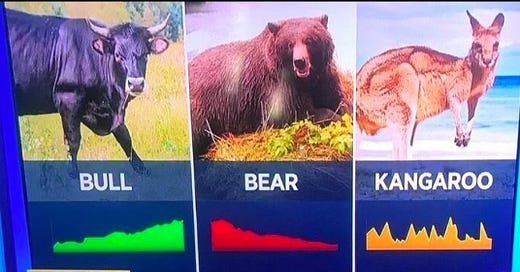On Wednesday, immediately after FOMC’s hawkish dot-plot update, our conclusion was that we are re-entering a period of weakness for equities and bonds. The Fed’s tone was hawkish, their projections geared towards a stagflationary scenario (lower growth, higher expected inflation), and this was interpreted as bad news for the market.
In addition, the uncertainty around the Israel-Iran conflict added to negative momentum, even though tensions seem to have been reduced. Trump gave it “another two weeks” to resolve, which means that we didn’t get that negative market impact.
Given all of this, it is no surprise that trading has been range-bound in June. On the SPX we have been ranging in a 100-point radius (this is very narrow, only 1.6%): between 5,940, unable to break below, and 6,040, unable to break above.
What catalyst can break this?
There are several potential ones, both to the upside and downside.
First the upside:
The Israel-Iran conflict is brought to a swift resolution. A peace treaty is agreed to or negotiated, there is no escalation and Iran agrees to a deal that disables their nuclear program. Also, the current Iranian regime might collapse from within, which delivers a quick victory to Israel, and the new Iranian administration starts negotiating immediate new terms with the US. This would act as a powerful catalyst to the upside, as uncertainty would be resolved and vol compression would be driving markets up.
Any positive update on tariffs - this is still the main concern for investors this year. It may involve several scenarios:
- a major deal can be announced - e.g. like the one with China, this time with other Asian trading partners (Japan, Korea, Vietnam, etc.), or with the EU.
- Trump may give another extension for negotiations - “another two weeks”, or otherwise signal that he is willing to give his trade partners more time to negotiate, eyeing good deals for everyone.
- Unlikely, but the administration could water down tariffs across the board, as their main goal - deal with China - was achieved (at least in the narrative).Macro data is actually better than what the Fed fears: the unemployment report in the first week of July comes in better than expected, as does inflation in the second week, plus GDP growth remains robust. This would make investors reprice the Fed signals, and treat the Fed’s reluctance to cut as another policy mistake. Especially if this continues into August data prints as well, before Jackson Hole.
If any of these happen, we get a sizable push up, and we might re-test all-time highs again (from February), and even surpass them if tariff uncertainty is significantly reduced. In other words, these would bring us back into the sideways-up regime over the summer, following the initial push up.
Below I discuss the probabilities for this.
Now the downside (basically the opposite of above):
The Middle East conflict escalates to the point where Iran attacks US military bases and triggers US involvement in the war. The VIX would explode on this news and push markets down hard. However, remember that war-induced vol spikes are always temporary, and when they mean-revert the upside push can be really strong. So if this does happen (hopefully it doesn’t), it is a good opportunity to short vol - i.e. short the VIX (through one of its ETFs like UVXY or VXX).
Recall the game theory matrix in case of WWIII:
- Buy & no WWIII: make big profits
- Don’t buy & no WWIII: you missed out
- Buy & WWIII: money is irrelevant
- Don’t buy and WWIII: money is irrelevant
I’m kidding a bit, but not really. Recall the market reaction to the Russia attack on Ukraine. Futures dropped 2% overnight, only to see the markets finish up by 2.5% at the end of the day. Incredible. Why? The doomsday narrative only lasts so long, the VIX spike presents a good short opportunity, the dips get bought, and we have a short squeeze on the way up.
Therefore, if Iran escalates, don’t panic. Wait a bit, then buy the dip and/or short vol.Tariff deadline passes and we get no clarity and no major deals. Trump may cave and give “another two weeks” (see above), but this will only add to uncertainty if no deals are made, and the administration continues to double down on tariffs. They are still the biggest source of uncertainty for investors and any bad news on that front is likely to keep pushing markets down. Maybe not as during April just yet (will have to wait for September for that), but further downside into 5,800 is possible. This will be a more sustained move, it won’t be like the Middle East conflict, as it will continue to add to the weakness, especially if the macro data keeps turning sour.
Macro data turns more stagflationary - aligned with the Fed’s expectations. This would cement the higher for longer stance from the Fed, which could be further amplified during Jackson Hole towards the end of August, which would set us up for a flush in September.
So, which of these scenarios have the highest probability?
Take a little break and help us make this newsletter even better
If you haven’t already, share your thoughts by filling out this short survey - it only takes a minute, and your feedback helps us shape future content.





